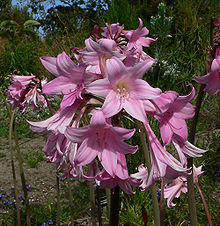Amaryllidacean alkaloids
Amaryllidaceae alkaloids are natural substances that occur in the amaryllis family .
Occurrence
Lycorin comes u. a. in the Belladonna lily . Galanthamine was first isolated from the bulbs of the Voronov snowdrop .
structure
The different structures can be formally derived from the same precursor, norbelladine . By oxidative coupling it gives the galanthamine type ( p - o coupling), the lycorin type ( o - p coupling) and the haemanthamine type ( p - p coupling). The alkaloids are linked by the amine tyramine and a C 6 -C 1 unit, which describes substituted benzaldehydes.
Representative
There are more than 300 amaryllidacean alkaloids.
Lycorin type
In addition to lycorin itself, representatives of the lycorin type are u. a. Caranin , Galanthin , Narcissidin and Norpluviin .
Galanthamine type
Representatives of the galanthamine type are narwedine and galantamine .
Haemanthamine type
Representatives of the haemanthamine type are u. a. Macronin , Crinin , Haemanthamin , Haemanthidin and Tazettin .
properties
Lycorin is highly toxic and is responsible for narcissus poisoning. As a translation inhibitor, it disrupts the protein synthesis of eukaryotic cells. Galantamine is a powerful analgesic and inhibits cholinesterase. It is used clinically as an anti-dementia drug . Lycorin and galanthamine cause the toxicity of numerous ornamental plants.
history
Galanthamine was first used in Russia in the form of hydrobromide to treat myasthenia gravis , a disease of the striated muscles with disorders of the cholinergic transmission. It was approved for the treatment of Alzheimer's disease in Japan in 1996 and is in advanced clinical development in the United States. In Europe, galantamine has been approved for the treatment of mild forms of Alzheimer's disease.
Individual evidence
- ↑ a b c d e f Entry on Amaryllidacene alkaloids. In: Römpp Online . Georg Thieme Verlag, accessed on April 22, 2020.
- ↑ a b c d e R. Hansel, O. Sticher: Pharmakognosie Phytopharmazie . 8th edition. Springer Medizin Verlag, Heidelberg 2007, ISBN 978-3-540-26508-5 , p. 1411 .
- ↑ E. Breitmaier: Alkaloids . Springer Fachmedien, Wiesbaden 1997, ISBN 978-3-519-03542-8 , pp. 71 .




